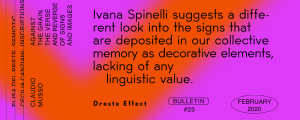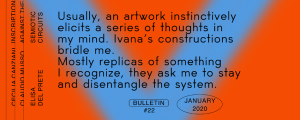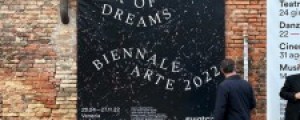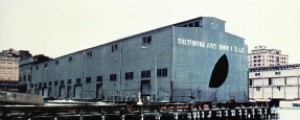Candice Breitz, The Woods, Perry Rubenstein Gallery, Los Angeles
In traditional fairy tales, a character’s entry into the woods often acts as a point of loss and discovery. Hansel and Gretel lose their way, Little Red Riding Hood realizes that her Grandma is not who she believes her to be, and independent of whom you are, something mysterious can always appear from the darkness. In The Woods, the newest series of works by Candice Breitz, there is no need to fear the people that are presented, but still things are not always as they appear.
Focusing on the three different major film industries of the world: Hollywood in the United States, Bollywood in India, and Nollywood in Nigeria, Breitz creates a complex view of the trials and tribulations of acting, focusing especially on the often surreal world of portraying youth on screen. Following in the tradition of her earlier work, each of the new works employees heavily edited and constructed video streams working in choreography between multiple channels. In The Woods works vary from the simplest construction in the dual screen interview of Nigerian film stars to the eight-channel investigation of young people starting their careers in Hollywood.

Candice Breitz, The Audition, 2012, From the trilogy The Woods
Shot at Independence Studio, Los Angeles, USA: September 2012
Six Channel Installation
Courtesy of the artist and Perry Rubenstein Gallery, Los Angeles.
Photo: Jeff McLane, 2013
Though exploring similar threads, each individual work within the series utilizes its own technique. In The Audition, a large and varied group of fresh faced hopefuls channel the words of casting agents, simultaneously presenting the shiniest, realist, most professional versions of their young selves while reciting a nonstop flow of verbiage that often is about the realities of rejection vs. performance that comes through years of experience. “Its just an audition” is a recurring phrase heard from different actors. In The Audition there are five channels of vertically oriented HD monitors framing an individual actor on a seamless white background with only a boom or an occasional hand written paper slate to remind of the Hollywood framing construct. Here the children appear in multiplicity and interchangeably, most often with different children on each monitor. They dance, sing, and act the lines that Breitz has provided. On the other three larger projected channels, the same children occupy the screen space unproduced – they are allowed to be “themselves” for a long 5 minutes. These screens are often uninteresting or awkward, with the real selves having a hard time keeping up with the produced selves.
The Rehearsal features six monitors of up and coming Bollywood actors in the formal framing of a PR junket. The teen actors here are all sourcing their text from the same location – interview material of Shah Rukh Khan, Bollywood superstar. As opposed to The Audition, where the children created a unified “voice” of Hollywood, The Rehearsal uses the individual actors to create a multifaceted view of a single individual. The teens voice an understanding of what it means to be a star, with quotations such as “I don’t think I’m a brand” and “Go wrong”. Unlike The Audition, the disconnect of the words and the bodies voicing them seems not as disconcerting; only the recurring themes amongst the identically staged screens gives away that text has been sourced elsewhere.

Candice Breitz, The Rehearsal, 2012, From the trilogy The Woods
Shot at Oakwood Premier, Mumbai, India: May 2011
Six Channel Installation
? Candice Breitz, 2013
Courtesy of the artist and Perry Rubenstein Gallery, Los Angeles.
Solely in The Interview is the visual style of documentary production as actual as it appears with known actors telling their personal story of superstardom. Much like Breitz’ recent work Factum, where identical twins appear on side by side monitors, telling two sides of their single story, The Interview functions similarly, as the two actors, Chinedu Ikedieze and Osita Iheme, are part of a duo that not only appears together as siblings in the majority of their work, but both have the additional responsibility of portraying children (due to their small physical stature) though they are well advanced into their adult life. Quoting a well-used American phrase Osita Iheme says, “They are brothers from a different mother.” In The Interview the core is not about the flexibility of identity, but about identity located, even though that identity permeates across two individuals.
The works are long in duration for video installation, each averaging about one hour. At this length, the exhibition is the equivalent to three feature films, and similarly each piece in this exhibition could have its own full write up. However collectively in the exhibition, they perform in a double capacity; each fulfills the quick view, the 1 minute long view, allowing the viewer to “get” the work and then move on, but also each piece grows in interest and meaning if a viewer has the time to devote to watch the work in its entire duration. Narrative based installations this long often crumble under the weight of their duration, making endurance part of the equation between the viewer and the viewed. However all three works in The Woods keep up a pace that makes them feel light, with edits that move between the different grouping of screens. As a viewer, attention moves between text, characters and screens; giving the full room an active and animated presence. Screens freeze, go dark, or silent creating this negotiated relationship between the viewer and Breitz’ editorial authorship.
The elegant simplicity of the exhibition design at Perry Rubenstein, with each of the individual works presented in their own stand alone gallery spaces, allows the technology to recede (but not completely dissipate) letting the conceptual text to shine through the monitors. Breitz’ work has long dealt with the sampled and reconstructed pop moment as a method to get to differences of the role and the individual filling that construct. In The Woods Breitz fuses the recent direct interview, non pop attributes utilized in Factum back again with her fascination with the entertainment industry to create something greater than the sum of its parts.

Candice Breitz, The Interview, 2012, From the trilogy The Woods
Shot at Wheatbaker Hotel, Lagos, Nigeria: June 2012
Dual-Channel Installation
? Candice Breitz, 2013
Courtesy of the artist and Perry Rubenstein Gallery, Los Angeles.
Breitz is crafting dual layered identities: adult/child, emerging/established, real/portrayed, individual/concept. The people on screen are not the global icons that Breitz has used in past, and while they are actors of varying degrees of notoriety, they are people first, allowing the concept of stardom to be present but not in the way of the work. Where is an actor’s core and how does that influence what is portrayed? In The Audition, during one of the five minute projected segments where the children are allowed to be themselves, there is a segment with Madison Dae Clarion that is cringe worthy. A tiny preteen girl, “her” time on screen is filled with her trying to fill that space of what she is with characters, accents, crazy stories and imagined interactions. In moments, she is everything that is bad about young child actors, and then in a flash of simultaneity, perhaps she is no different than any other child playing pretend and making up conversations. In The Interview, Ikedieze and Iheme discuss what it is like to be constantly confused for the roles that they have made famous and also for each other, seemingly ok that their actual identity has gotten lost in the shuffle to those that have made them stars.
Which choices are theirs and which are the role? Other media artists such as Gillian Wearing and Clio Barnard have taken this concept up in recent years as well, using the non-fictionalized texts and interviews being performed by actors, exploring similar themes. In The Woods, Breitz’ fusion of older ideas and newer approaches in her practice create a series of works that are dynamic, smart and a little addictive. Much like reading a long form interview about a person that you never knew that you cared about, The Woods’ constant barrage of revelations keep an audience compelled and this longer viewing time allows for the more interesting questions and ponderings to formulate.
Candice Breitz, The Woods, Perry Rubenstein, Los Angeles through December 14th.
by Astra Price
in Focus on the American West
Dec 5, 2013





















